This post includes a number of statistics found in an in-depth study titled “Financing Green Infrastructure” published by ICMA (International City/County Management Association) in May 2022 — click here to read the report in full.
Introduction
As the social and environmental benefits of green infrastructure (GI) gain more and more traction among municipal project planners, the question of economics becomes paramount: how affordable is GI versus other city investments, like gray infrastructure, and what are the long-term financial implications of adopting a green infrastructure strategy?
Let’s explore exactly what green infrastructure is and identify its numerous advantages (with a focus on the economics). Indeed, while the perceived front-end cost of GI often presents an obstacle for landscape architects and city planners, understanding its long-term financial value — and how a well-executed green infrastructure strategy will actually save money in the end — is crucial, and should ideally lead to greater implementation: a win for cities and citizens alike.
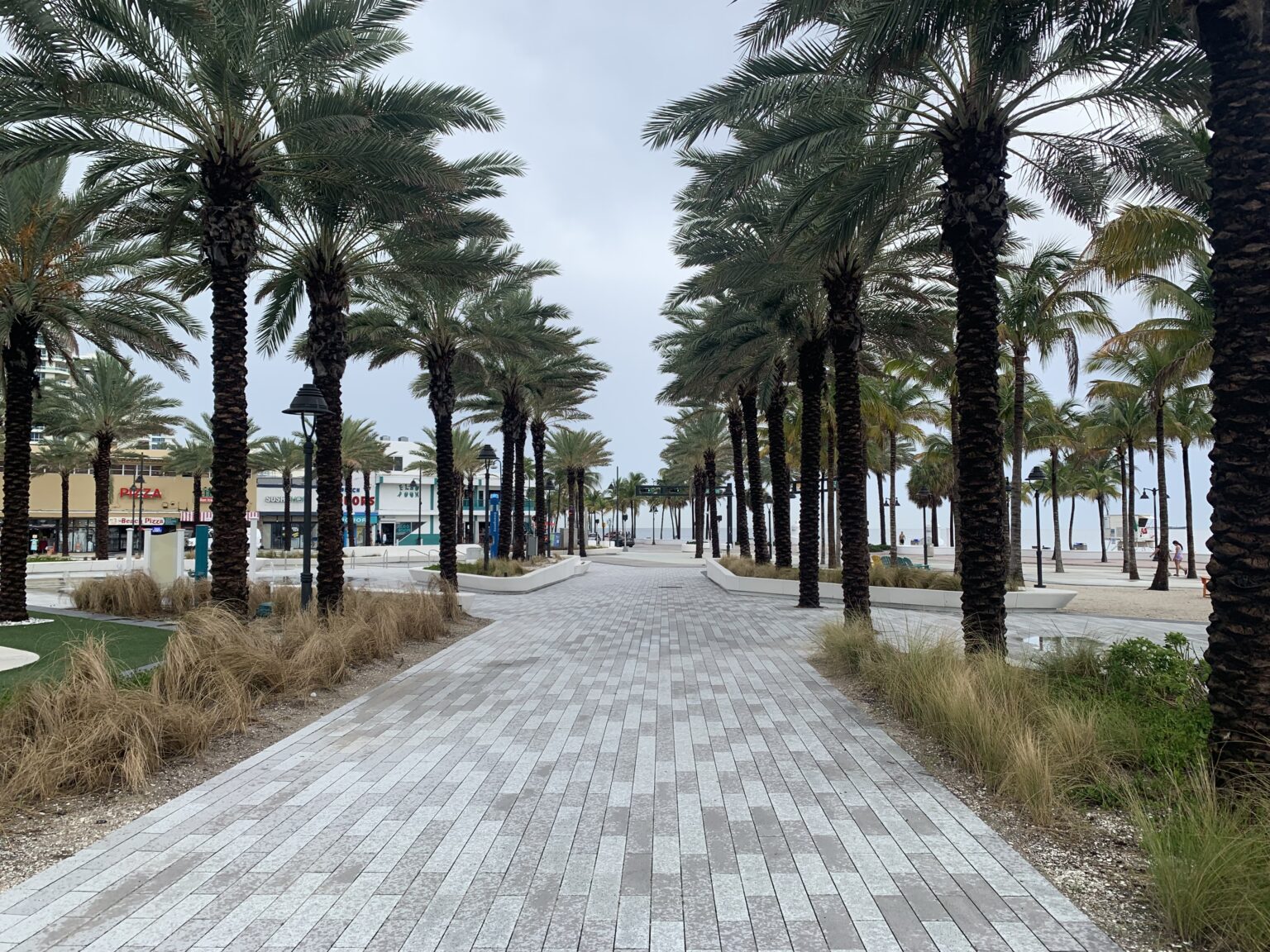
Altos Del Mar Park, Miami Beach, Florida
What is Green Infrastructure?
There are numerous definitions of what green infrastructure is. One of the earliest attempts to define GI came in the mid-1990s from The Florida Greenways Commission: “A strategically planned network of natural areas, parks, and other green spaces with conservation value.” Green Infrastructure Ontario defines it as “The natural vegetative systems and green technologies that collectively provide society with a multitude of economic, environmental, health, and social benefits.” The EPA focuses on stormwater in its categorization, defining GI as “Using soils, vegetation, and other natural systems to infiltrate, evapotranspirate, and/or recycle stormwater runoff.”
Regardless of its precise definition, green infrastructure is a landscaping strategy incorporating green elements to benefit the region environmentally and socially — and, indeed, as we’ll examine further, economically. Examples of these elements are wide ranging and include urban forests, bioswales, stormwater ponds, green roofs, parks, gardens, wetlands, and more.
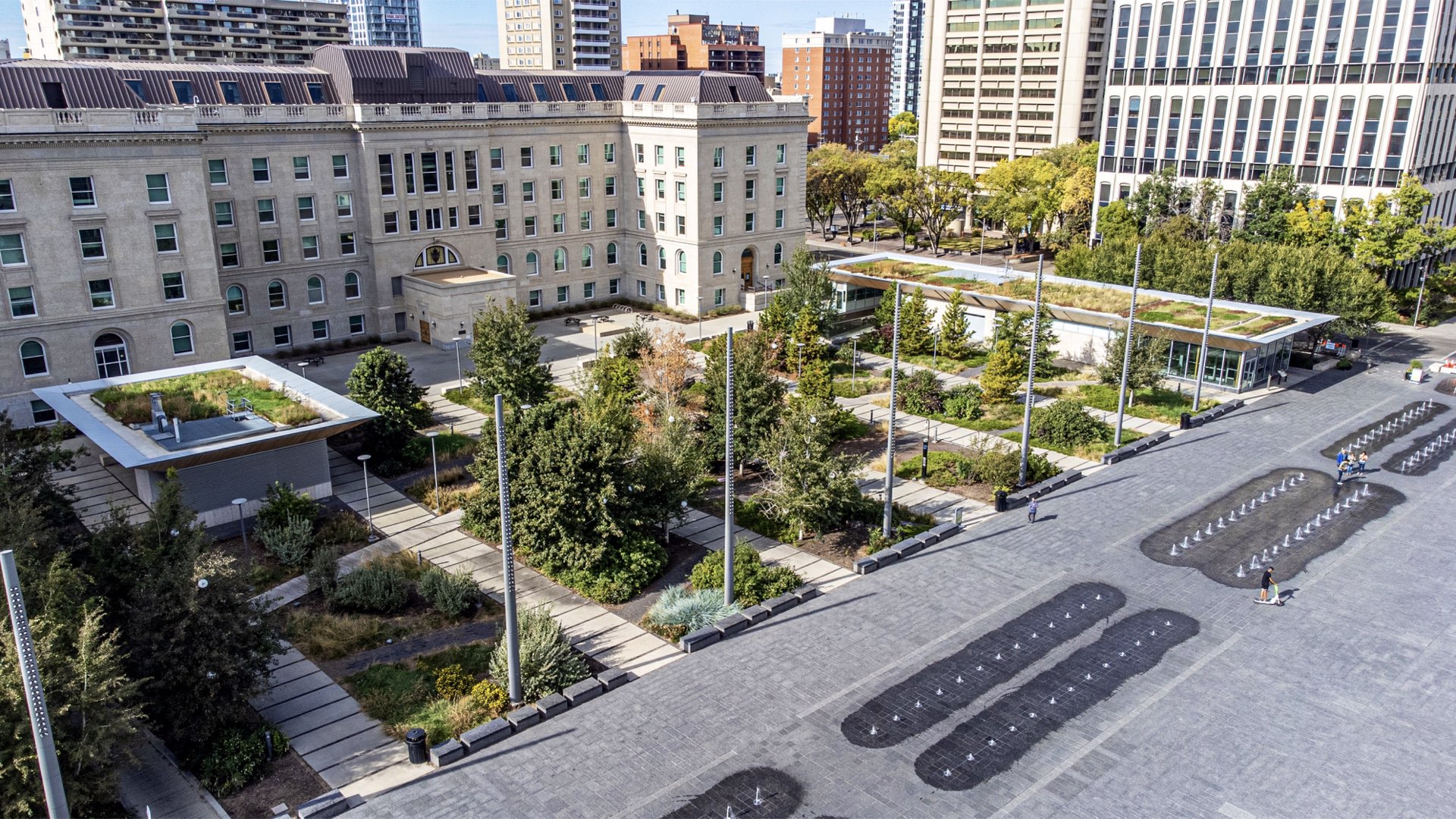
Queen Elizabeth II Building, Edmonton, Alberta
Social and Environmental Benefits of GI
The many social and environmental benefits of green infrastructure are becoming well established among project designers. Connecting residents to nature in an urban setting, while also using that nature as a functional system to support the health of the local environment, is a growing practice within the landscape architecture industry.
Some of the many social and environmental perks of GI include:
- Lowered Heat Island Effect: The heat island effect occurs in urban areas in which there is little to no tree coverage providing shady respite. The consequences of this are immense, including premature death. Growing large, healthy trees helps mitigate this dangerous environmental condition.
- Improved Public Health: A number of improved physical health attributes have a proven correlation to the existence of green infrastructure, including lowered pollution, reduced heat, and heightened physical activity and lowered mental health concerns among residents.
- Stormwater Treatment: Many GI elements are able to assist in at-source stormwater treatment, cleaning the rainwater before it enters the sewer system or local waterways and reducing peak-flow concerns during major storm events.
- Green Community Gathering Space: The health and vitality of a community is a difficult thing to quantify; nonetheless, it’s evident that by providing residents with a welcoming outdoor gathering space, the chances of greater community engagement are exponentially increased — whether it’s simply meeting for a walk or organizing largely attended events such as concerts or farmers markets.
- Climate Change Mitigation: By incorporating natural carbon-removing elements like trees, green infrastructure helps slow the progression of climate change.
Many of these social and environmental perks also include a financial component, as we’ll examine in greater detail.
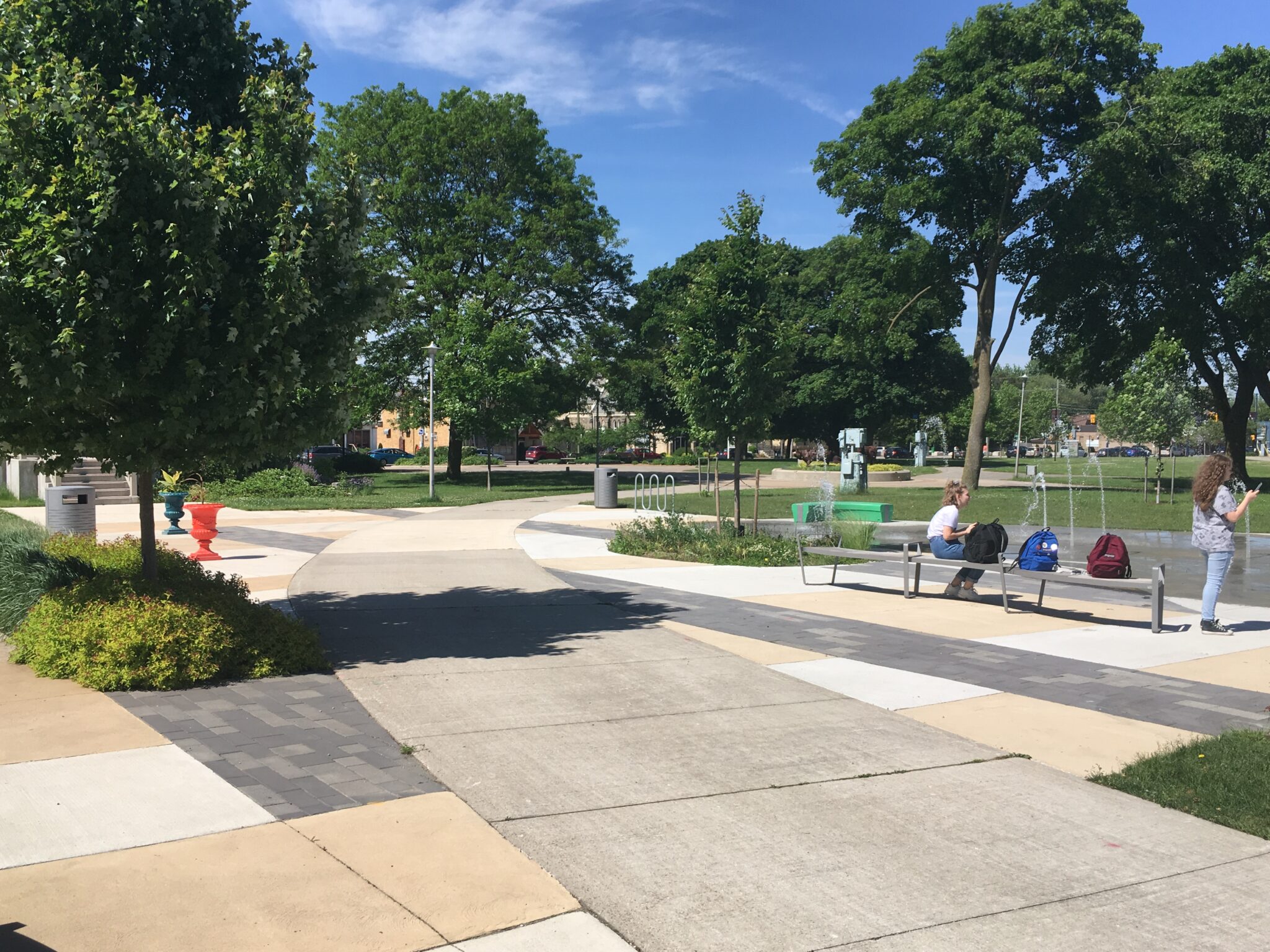
Queens Park, London, Ontario
The Economics
Less understood when it comes to the advantages of green infrastructure is the multifaceted positive impact it has on the economic health of a community. Two illuminating Pennsylvania-based studies were conducted that help us better grasp the true financial benefits of GI: one is from Chester County (population 500,000) in which they studied the potential return on investment of GI, and the other in the town of Lancaster (population 60,000) where they assessed the impact a proposed green infrastructure plan would have on the local community. There are also a number of additional regional assessments upon which we draw to provide statistical context from areas across the country. Again, as mentioned at the top, please check out the comprehensive ICMA research paper, “Financing Green Infrastructure,” for a complete look at this work.
Stormwater
Managing on-location stormwater is one of the most important factors in any urban landscaping initiative. Paved areas create an increase in unclean water from street and sidewalk sediment and pollutants, water runoff that eventually drains into local rivers, lakes, and oceans. By implementing a GI system — like the DeepRoot Silva Cell — that helps treat this stormwater before it even reaches the sewer network, the downstream cost savings are significant.
- The Chester County study determined that the value of GI stormwater pollutant removal (per acre) was substantial: $16 per year for nitrogen, $256 per year for phosphorous, and $1,595 per year for sediment.
- The total estimated value of GI stormwater pollutant removal determined by Chester County was $107 million in total avoided costs (and $8.2 million in other annual water-quality benefits).
Pollution
In addition to helping with water quality, green infrastructure can also improve urban air quality. Natural greenery like trees assist in removing harmful pollutants from the air while also capturing carbon, benefitting both the local community and the environment at large.
- The Lancaster study estimated $1 million in yearly air-quality improvements provided by GI (removing nitrogen dioxide, PM-10, and sulfur dioxide). The same assessment conducted by the larger-population Chester County estimated the GI air-quality value at $13.5 million annually.
- The carbon-capture benefits of protected GI open spaces were approximated at $120 million by Chester County.
Energy Savings
In helping to mitigate the urban heat island effect, green infrastructure has a tangible value in energy savings provided by its natural cooling benefits.
- Street trees in Grand Rapids, Michigan, saved residents a total of $722,000 in annual energy expenditure.
- Chester County estimated $2.4 million in annual energy savings from GI ($1.8 million in natural gas and $0.6 million in electricity).
Local Economy
Finally, an often-overlooked feature of green infrastructure is its positive impact on the local economy. This includes everything from property values and job creation to the benefits realized by businesses operating on streets with GI.
- Chester County estimated 1,800 new jobs would be created from GI protected open spaces (including maintenance, agriculture, and tourism).
- Research conducted by urban designer Dan Burden suggests that businesses operating on streets with trees earn 12% more income than those without. And mature tree canopy streets allowed businesses to charge an 8-12% premium on their products and services.
- Property value also increases in proximity to GI. Chester County estimated an additional $27.4 million in additional annual tax revenues from green infrastructure-created property value increases.
Conclusion
Incorporating green infrastructure into municipal design plans helps deliver a number of tangible financial benefits in both the short- and long-term. By some estimates, utilizing GI situationally in place of gray infrastructure yielded a savings of 25% — in fact, Chester County’s final tally on the economics of GI approximated the yearly savings in avoided gray infrastructure to be $27 million in maintenance costs alone. By understanding these real economic advantages, we can begin to implement greener and more sustainable revitalization projects in urban environments across the globe.
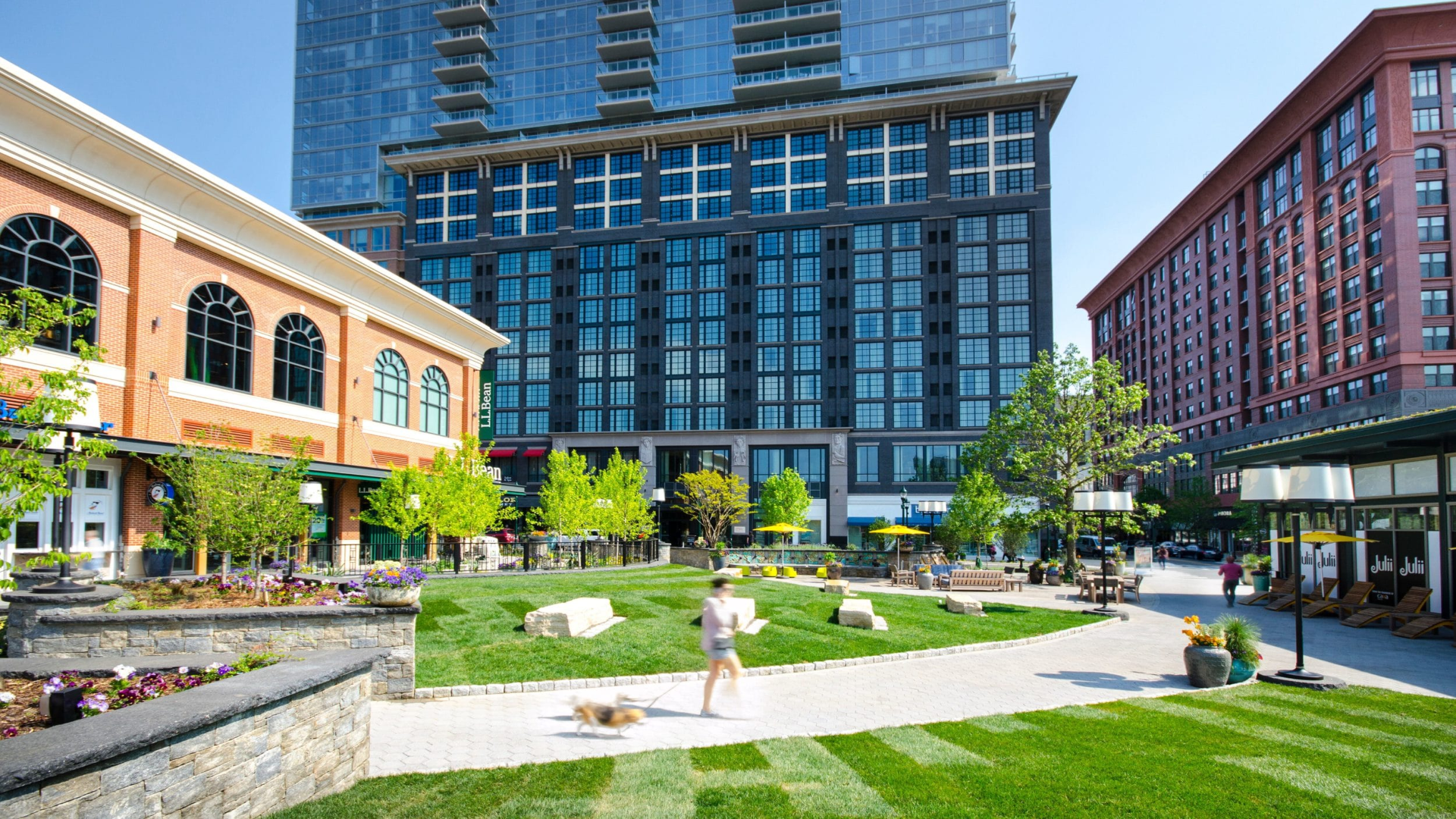
Pike & Rose, Bethesda, Maryland

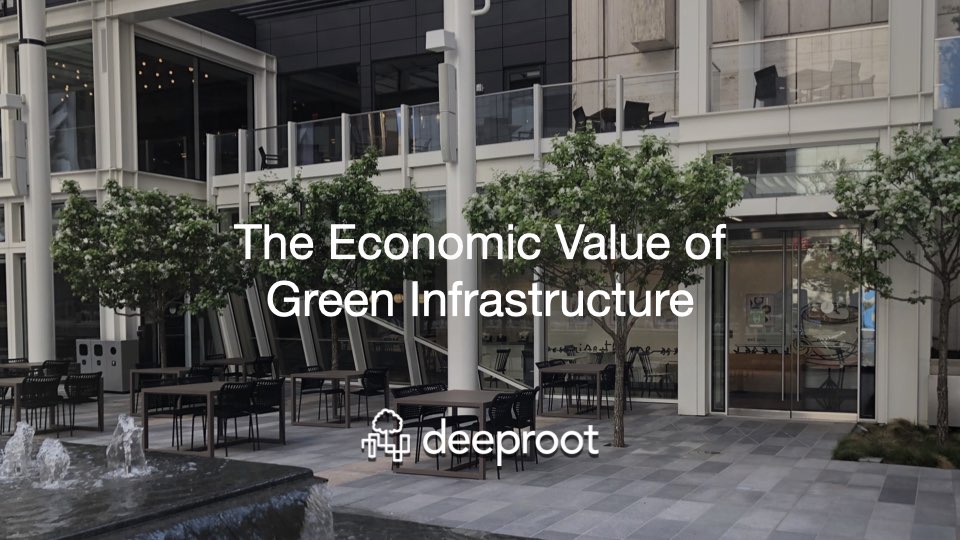




Leave Your Comment